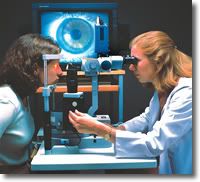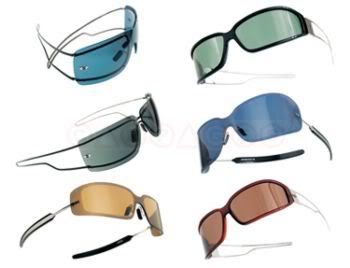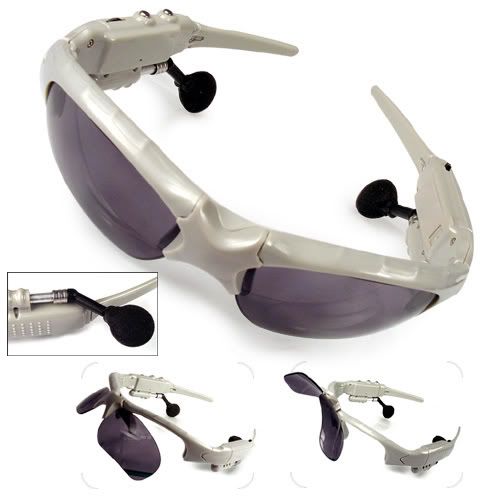Introduction
Optical magnifiers, such as hand and stand magnifiers are commonly prescribed to assist visually impaired people with reading. The task for which a magnifier is used may vary from spot reading, such as finding the total on a utility bill, to fluent reading of a newspaper or a novel. Due to the restricted field of view, the magnifier has to be moved to locate the required information (e.g., the total on the utility bill) or the start of a new line, and/or read a line of text. Good control and the adoption of efficient patterns of magnifier movement are fundamental to the successful use of both hand and stand magnifiers. Clinical experience suggests that some patients have difficulty with navigating a magnifier around the page, reporting that they miss lines or repeat lines when reading. An understanding of how visually impaired readers actually use their hand and stand magnifiers is relevant to the development of improved methods of training.
Previous studies of magnifier movements have either used fully-sighted participants reading with optical magnifiers or visually impaired participants reading with closed-circuit television (CCTV) systems; to our knowledge magnifier movements of visually impaired readers using optical magnifiers have not been investigated. Optical magnifiers tend to be prescribed more commonly than CCTVs and the method of using an optical magnifier is very different from that of a CCTV. In the study by Neve, hand magnifiers were moved across a glass plate, which was positioned parallel to and at a fixed distance from the text; thus the participants did not have to maintain the magnifier at the correct distance from the page, which removed one of the usual requirements of using a hand magnifier.
Discussion
Magnifier movement patterns
When reading along a line (forward phase) participants primarily used either a straight or diagonal downward movement. A straight movement, keeping the vertical positioning of the magnifier constant across the line, is the movement pattern that we expected for the forward phase; the downward movement was surprising. The vertical displacement per line in the forward movement was typically about 13% of the vertical field of the magnifier and would probably have had little functional impact on navigation or reading performance, as the participant would have been viewing through relatively central parts of the lens at all times. Only 3 of the 20 participants for whom vertical field was measured showed vertical displacements of more than 30% of the vertical magnifier field. This might have resulted in the text of interest being viewed through peripheral lens areas with poor image quality, or possibly even outside the field of the magnifier. These 3 participants used magnifiers with very restricted vertical apertures (less than or equal to 2.5cm or 5 lines) and 2 of them demonstrated poor forward navigation performance.
During the retrace phase, the majority of participants used a downward movement, with only a minority using a straight or upward retraces movement, such that the most common forward and retrace movement pairing was a straight movement during the forward phase followed by a downward retraces movement. Some low vision practitioners train patients to use navigation strategies involving a straight retrace movement, retracing the magnifier along the line just read and then moving down to the next line. If patients are not taught specific retrace strategies, as was the case for our participants, it appears that they naturally use a diagonal downward retrace movement when using a hand or stand magnifier. A diagonal downward retrace strategy is the most efficient in terms of distance traveled, but is possibly more difficult to perform accurately than a straight retrace strategy. By comparison, Beckmann and Legge reported for low-vision and normally-sighted readers using CCTVs, that the most commonly used retrace movement was the straight strategy of returning along the line just read and then dropping down to the next line, which is probably the easiest strategy when controlling the XY platform of a CCTV.
This is the first attempt to categorize observed patterns of magnifier movements when reading with optical magnifiers and we might have used too stringent a criterion for differentiating straight and non-straight movements. Furthermore, the magnifier movements were only recorded in one set up, which although it attempted to approximate the habitual reading situation was nevertheless not the participant’s usual reading environment. Different movement patterns might have been recorded if we had used a flat rather than an inclined reading stand.
Errors of navigation
The main errors of navigation during the forward phase were regressions, pauses and variations in the vertical position of the magnifier, which usually resulted in corrective vertical movements that were smaller than the 0.5cm inter-line separation. Pauses and regressions are evidence of poor coordination between hand (magnifier) and eye movements, e.g., the magnifier was moved too quickly such that a word was missed or there were difficulties with visual word recognition (if part of the word fell within the scotoma). By comparison the main navigation error during retrace was incorrect vertical positioning of the magnifier at the start of the next line resulting in a number of corrective vertical movements at the end of the retrace phase that typically were larger than the 0.5cm inter-line separation. The retrace movement (unlike the forward movement) is a fast movement and is unlikely to be closely visually guided, resulting in position errors which are only detected and corrected at the end of the retrace when close visual guidance is again engaged prior to reading the next line. For normally-sighted participants using hand magnifiers, Neve also reported a greater number of pauses and corrections at the start of a new line, than the middle or end of the line.
Our magnifier movement recordings show clear evidence that some participants had difficulty finding the start of the next line. It is possible that retrace performance could be improved by skills training to use specific retrace strategies (but to our knowledge this has never been evaluated with magnifier movement recordings), or by using additional devices such as a finger placed at the start of the line just read, a typoscope placed under the line or a line guide fitted to the base of a stand magnifier.
Subjective ratings of page navigation difficulties
Subjective estimates of page navigation difficulties were not related to any of the objective measures of page navigation performance. Given that 63% of participants reported missing a line sometimes or frequently when reading and 81% reported at least some difficulty with retrace, we expected to find more evidence of page navigation difficulties from the magnifier movement recordings. In fact only a minority of participants (12%) made a large number of navigation errors and there were very few missed or repeated lines. There are a number of reasons why this might be the case. Participants based their ratings of perceived difficulty on their experience of using the magnifier at home. These ratings were made prior to the reading test so it is possible that difficulty estimates might have been lower if based on the passages and reading environment used in the study. Participants probably read more carefully under the experimental conditions than they would at home, therefore fewer navigation errors might have been recorded than would normally occur. Our assessment and data analysis methods may have been insensitive to evaluating relevant page navigation skills, e.g. it is possible that our passages were too short to properly evaluate navigation problems. On the other hand, it is not surprising that some visually impaired people may overestimate the difficulties they encounter when using their magnifiers. The discrepancies between self-reported and measured functions may be due to different underlying expectations and experiences. Clinical experience suggests that many patients may have unrealistic expectations about reading with magnifiers and become frustrated by the slow reading speeds, short working distances and the need to move the magnifier about the page, which may contribute to overestimation of their difficulties.
Factors affecting page navigation
As expected, forward navigation time was longer than retrace navigation time and vision measures (primarily near word acuity) were more strongly associated with forward navigation performance than retrace navigation performance, reflecting the greater degree of visual and cognitive processing that occurs when reading along a line than the minimal processing that occurs during retrace. Although horizontal field of view was related to navigation times, especially forward navigation time, it was unrelated to either forward or retrace navigation errors. In general navigation errors were not well predicted by any of the vision or magnifier measures we evaluated. We did find a modest correlation between vertical field of view and retrace errors (narrower field, more errors), suggesting that the vertical magnifier field is important in the retrace phase of navigation; however, vertical field was measured for only 20 of the 43 participants. Navigation errors might be better predicted by other factors that we did not evaluate in this study, in particular motor skills including hand-eye coordination and manual dexterity. The relationships between visual impairment, manipulative skills, hand-eye coordination and page navigation skills is an important area for future investigations.
Contrary to our expectations, neither experience nor frequency of magnifier use had any significant association with magnifier movement patterns, magnifier movement parameters or navigation errors. Page navigation skills might develop rapidly in the first few weeks after a magnifier is prescribed, but we had only 4 participants whose magnifier had been prescribed within the previous 2 weeks so we could not assess this in our sample. A longitudinal study, following participants from the time when the magnifier is first prescribed, would enable changes in navigation skills and magnifier movement strategies to be examined as participants learn to use the device.
This is the first study that has recorded magnifier movements from a relatively large sample of older visually impaired patients using optical magnifiers. We were able to quantify page navigation strategies, difficulties with page navigation and the ability of patients to hold a hand magnifier at a constant distance from the page. In the clinical setting it would not be practical to record magnifier movements. However, we suggest that in addition to assessing reading speed, low vision practitioners should routinely observe how patients move their magnifier when reading a short paragraph. Although we used experimental conditions that approximated real-world reading conditions and participants who represent the majority of elderly visually impaired people, our findings are limited to one set of reading conditions - reading short passages with hand or stand magnifiers. Nevertheless, this study provides a strong basis for future investigations, including changes in navigation skills after a magnifier is first prescribed, the impact of training specific navigation strategies, the use of devices to aid navigation and the relationship between motor skills and navigation skills.
Conclusions
We quantified page navigation strategies and difficulties of people with AMD reading with magnifiers. Retrace, which presents the most common difficulty, is not well predicted by vision measures or magnifier characteristics; future studies should investigate the relationship between motor skills and navigation performance, and the impact of training or devices on reducing retrace navigation difficulties.



